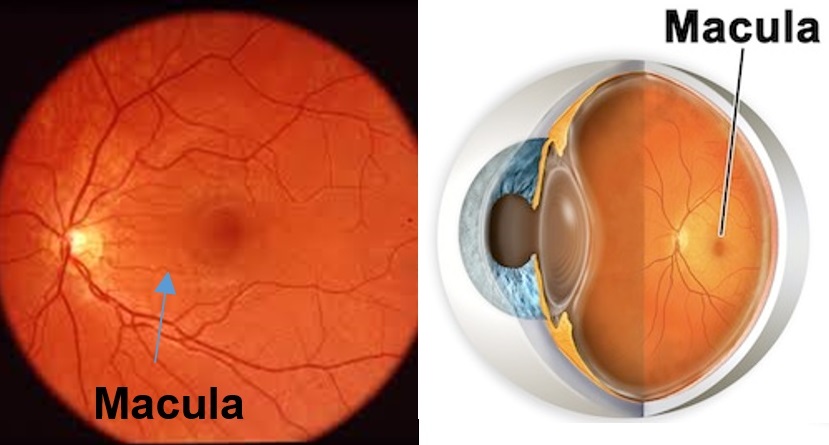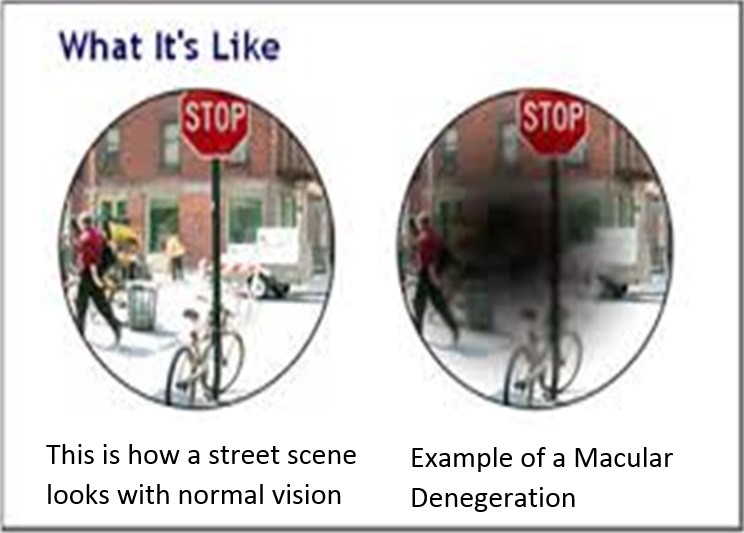What is macula?
Macula is a small area in the retina that is most sensitive and important for good vision and colour vision. Healthy macula allows you to thread a needle, read small prints, and read street signs.
 |
What is degenerative macula?
Degenerative macula is an unhealthy change in the macula, without any apparent cause, that can cause disturbance in the eyesight.
What is Age Related Macula Degeneration (ARMD)?
ARMD is a condition that occurs when the unhealthy changes of the macula happened without any obvious cause, generally occurring in older patients.
ARMD is a major cause of blindness and visual impairment in older adults, affecting 30-50 million people globally.[1] ARMD can lead to difficulty in doing activities like reading or recognizing faces.
TYPES OF ARMD
| Dry ARMD | Wet ARMD |
 Macula showing multiple drusens Macula showing multiple drusens |
 Macula showing bleeding (hemorrhage) Macula showing bleeding (hemorrhage) |
| Dry Macular Degeneration is the most common type of ARMD. It is characterized by the appearance of drusens, which are small yellowish deposits. Most people with these early changes still have good vision. The risk of developing visual disturbance is higher when the drusens are large and numerous. | Wet Macular Degeneration occurs in approximately 10-15% of ARMD patients. Abnormal blood vessels grow beneath the retina and leak fluid or bleed, causing distortions and blurred vision leading to irreversible damage and rapid vision loss if left untreated. Although there are several types of treatments for the wet type, none will restore the lost vision. |
What causes ARMD?
As you get older, retinal metabolisms is not as efficient as it used to be.
Waste products start to build up in your retina and form small deposits, known as drusens. A build-up of drusens, combined with a lack of nutrients, cause damage to the light cells in your macula and the cells stop working. If the light cells in your macula are damaged, your central vision will become blurry and less well-defined.
What are the symptoms of ARMD?
ARMD can affect one or both eyes.
In the early stage, patient will not have any symptoms. The patient may not be aware of any visual disturbances if only one eye is affected, and the other is seeing well.
ARMD is painless.
At first, ARMD often causes slightly blurred central vision, both near and far and straight lines may appear wavy. The centre of vision may become fuzzy or shadowed and this area may grow larger as the disease progresses. Central dark spots may develop, and people normally have more difficulty. At first, ARMD often causes slightly blurred central vision, both near and far and straight lines may appear wavy. The centre of vision may become fuzzy or shadowed and this area may grow larger as the disease progresses. Central dark spots may develop, and people normally have more difficulty seeing colour and fine detail. In severe form, central vision loss can occur rapidly, sometimes within days or weeks.
 |
 |
| Normal visual field | Visual field of ARMD patient |
| Simulation of normal vision (left) and distortion due to metamorphopsia |  |
| Simulation of normal vision (left) and vision with central blind spot (scotoma) combined with distortion |  |

Aging – the risk to develop ARMD increases with age.What the risk factors for ARMD?
- Smoking – Smoking will affect the oxygen supply to the retina, thus increase risk of developing ARMD.
- Family history – If there is any close relative has ARMD.
- Prolonged exposure to sunlight – UV light can damage retinal cells and increase the risk of ARMD.
- Diet – Consuming high fatty food, cholesterol and sugar and low anti-oxidant and green vegetables can contribute to development of ARMD.
- High blood pressure
- If one eye had developed ARMD, the other eye also has similar risk to develop ARMD.
What is the treatment for ARMD?
There is as yet no outright cure for age-related macular degeneration, but some treatments may delay its progression or even improve vision. However, a large scientific study has shown that antioxidant vitamins and zinc may reduce the impact of macular degeneration in some people by slowing its progression toward more advanced stages.
Tips for Protecting Eye Health and Preventing Macula Degeneration
These suggestions may help protect vision and improve your overall health, and some may lower the risk of developing ARMD. Even if you already have ARMD, continue these healthy habits:
- Maintain a healthy weight.
- Eat a nutritious diet that includes green leafy vegetables, yellow and orange fruits, fish and whole grains.
- Don’t smoke.
- Maintain normal blood pressure and control other medical conditions.
- Exercise regularly.
- Wear sunglasses and hats when you are outdoors.
- Get regular eye examinations, and consult your doctor if you notice vision changes.
References & Notes
- Some of the information in this section was obtained from the National Eye Institute and the National Library of Medicine.
- Lutein + zeaxanthin and omega-3 fatty acids for age-related macular degeneration: The Age-Related Eye Disease Study 2 (AREDS2) randomized clinical trial. JAMA. Published online May 2013.
- Cardiovascular risk factors and age-related macular degeneration: the Los Angeles latino eye study. American Journal of Ophthalmology. February 2008.
- Dietary carbohydrate and the progression of age-related macular degeneration: a prospective study from the age-related eye disease study. American Journal of Clinical Nutrition. 2007.
- Physical activity and the 15-year cumulative incidence of age-related macular degeneration: the Beaver Dam Eye Study. British Journal of Ophthalmology. October 2006.
- Cigarette smoking, fish consumption, omega-3 fatty acid intake, and associations with age-related macular degeneration. Archives of Ophthalmology. 2006.
- Dietary fatty acids and the 5-year incidence of age-related maculopathy. Archives of Ophthalmology. 2006.
- Comprehensive adult medical eye evaluation, preferred practice pattern. American Academy of Ophthalmology. 2005.
- Prospective study of intake of fruits, vegetables, vitamins and carotenoids and risk of age-related maculopathy.Archives of Ophthalmology. 2004.
- Smoking and blindness. British Journal of Ophthalmology. 2004.
- Progression of age-related macular degeneration: association with dietary fat, transunsaturated fat, nuts, and fish intake. Archives of Ophthalmology. 2003.
- Age-related eye disease study group. A randomized, placebo-controlled, clinical trial of high-dose supplementation with vitamins C and E, beta-carotene and zinc for age-related macular degeneration and vision loss. Archives of Ophthalmology. 2001.
- Effects of a combination of beta carotene and vitamin A on lung cancer and cardiovascular disease. The New England Journal of Medicine. 1996.
- Dietary carotenoids, vitamins A, C, and E, and advanced age-related macular degeneration. Eye disease case-control study group. Journal of the American Medical Association. 1994.
- Eye health: macular degeneration. BMJ Specialist Journals.
| Last Reviewed | : | 23 August 2019 |
| Writer | : | Dr. Zaidah bt. Mohd Kasim |
| Accreditor | : | Dr. Salmah bt. Othman |
| Reviewer | : | Dr. Rosniza bt. Ab. Razak |







